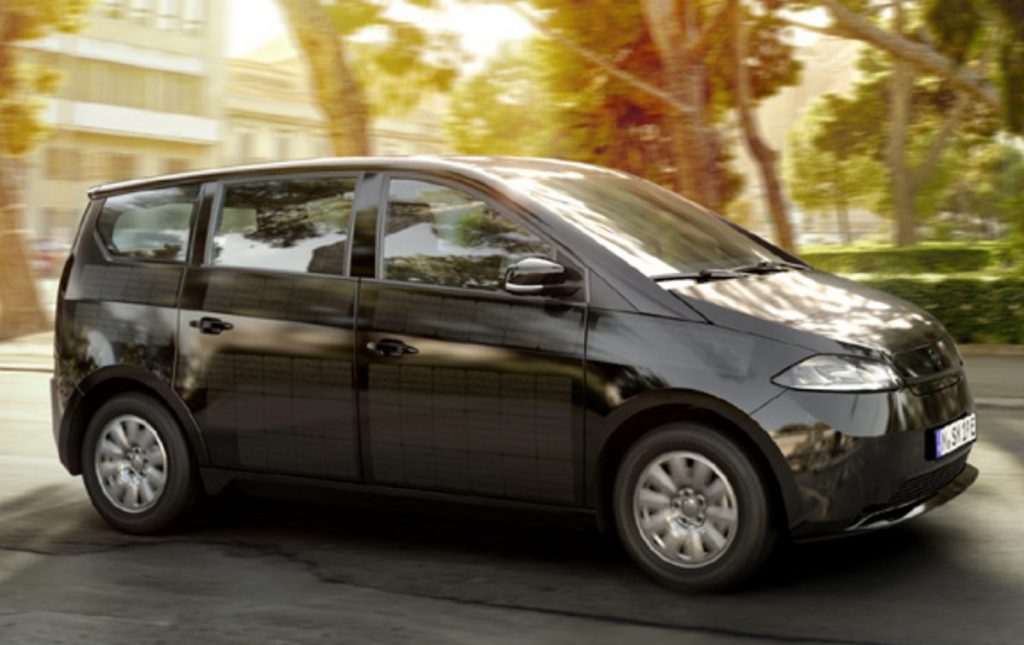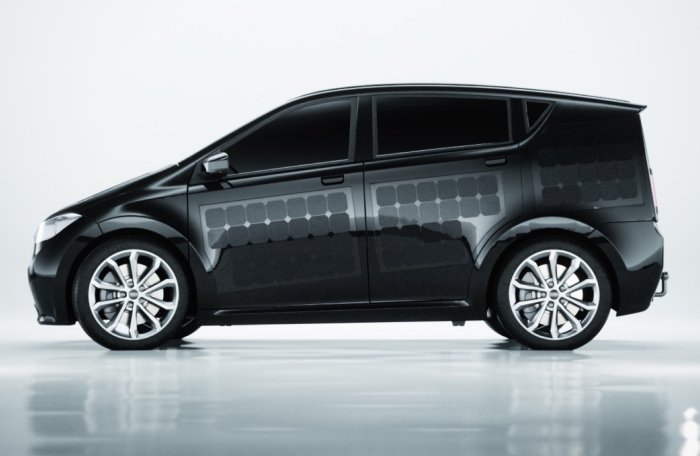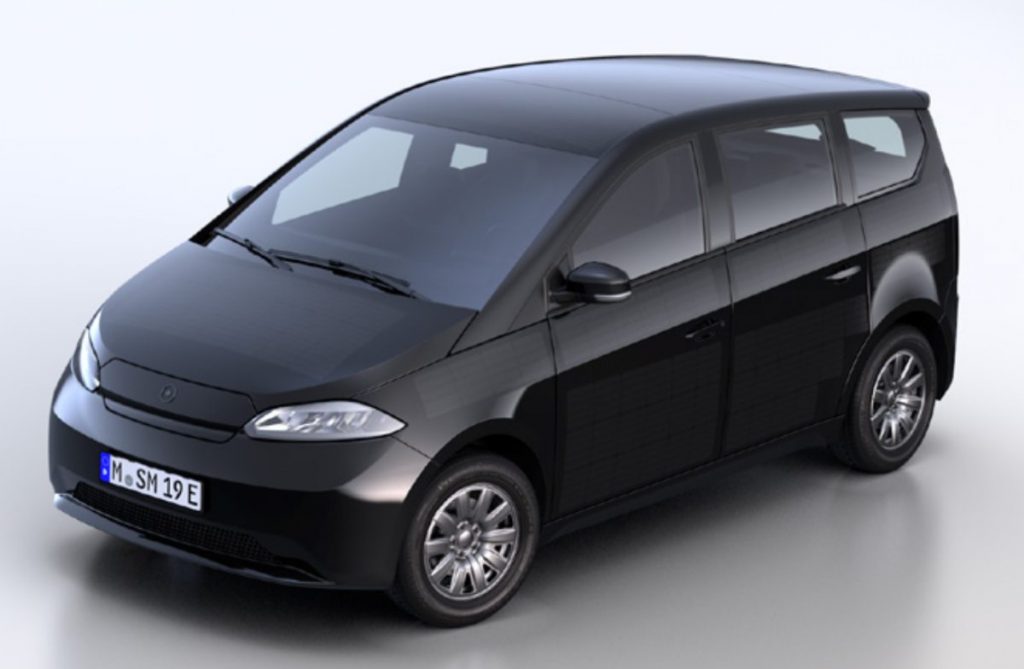
Germany’s Sono Motors has released the first images of its solar power assisted electric car – the Sion – as it will appear at market launch.
We first mentioned the Sion back in 2017 – here’s what the design looked like then.

In the final design, the monocrystalline solar cells on the fenders, sides, roof and rear of the car appear to be less prominent.
“The production vehicle will feature full-surface integrated solar cells that are embedded in hard-wearing, resilient polymer and that contribute to the vehicle’s design aesthetic thanks to optimized color matching,” said Sono Motors’ Mathieu Baudrit.
It’s not clear if the solar cells are still being supplied by SunPower as in the prototypes.
According to Sono Motors, the solar cells can provide up to 34 kilometers of additional range a day at peak performance. The “up to” is the important bit. Undercover/shaded parking isn’t going to be helpful in achieving that and parking the car out in the sun on a summer’s day will mean cranking up the air conditioner. On an “average” day, which I’m guessing is based on Germany’s conditions, Sono puts the solar range at between 5 – 22 kilometres depending on the time of the year and on a cloudy day, at 3 – 11 kilometres. At peak performance, the solar cells can generate 1.2kW of power.
The Sion’s lithium ion battery back has a capacity of 35 kWh and Sono Motors claims a range of 250 kilometers (255 kilometers under the WLTP[1.Worldwide Harmonized Light-Duty Vehicles Test Procedure] standard). The company intends rent/lease or outright purchase options for the car’s battery.
As well as storing energy, the battery can share it too – it’s able to power devices up to 3.7kW.
The Sion has a three-phase synchronous motor offering a maximum of 120 kW of power (163 HP) and maximum 290 Nm of torque.
The final design of the Sion is longer and wider than the 2017 version – 4.29m x 1.83m. The EV will weigh approximately 1.4 tonnes, including the battery.
How Much Will A Sion Cost?
Something else that’s changed is the Sion’s price. Back in 2017, the car’s price was estimated to be under AUD $30,000 at exchange rates at the time and not including import costs for Australian buyers. Sono Motors says for its market launch, the cost will be 25,500 euros including the battery, which is around AUD $40,770 at current exchange rates. The company has given itself a bit of wiggle room there as on the pre-order page it states (bolding mine):
“The basic price for the vehicle is 16,000 euros plus the cost of the battery, which we expect to be around 9,500 euros.”
There has been significant interest in the Sion, with the company claiming 9,460 partially paid pre-orders to date.
A Sion information sheet with more photos of the car can be downloaded here.


 RSS - Posts
RSS - Posts



Nice to have solar cells on a production car. I think a major reason they leave them off other EVs so people won’t park them in the sun and fade the paint. (Can’t have a Tesla S looking shabby!) Mind you, putting solar cells on a car and having them operate reliably for many years isn’t easy.
So maybe $41,000 for 250 km range plus whatever the solar cells give you vs. maybe $54,000 for a Tesla model 3 and 350 km. (Those ranges should be reasonably realistic.) If that’s the only difference, the extra 100 km of range would be nice but not worth for most people since the $13,000 difference would pay for a lot of car rental if the Sion’s range was not suitable for a trip.
Wouldn’t want a dark coloured car in Australia, but I have seen pictures of a white prototype that lets everyone see you have solar panels on your car.
Tend to disagree Ron – solar panels on cars make little to no sense and are a waste of resources. Apart from the obvious problems you pointed out (your car lasts a lot longer if you garage it and most commercial garages are undercover), while the panels on the top of the car may be effective the other panels on the side of the car will be very inefficient. Averages say that in Australia a rooftop 1.2kW system might generate about 5kWh daily (depending on where you live) and your average EV does about 5-7km to the kWh so that’s where they get their additional range figures from (assuming no charging losses which is also unrealistic). The car would have to be in the sun all day and all the panels would have to be roof mounted and tilted north or west. Lets be generous and say these panels operated at 50% efficiency of a roof mounted system – now where down to half the range. Before shading etc. The quoted extra range estimates are wildly optimistic. It would be much better re-purposing these panels in the proper orientation at a charging station with storage. I suppose 10km average (my guestimate) is better than nothing but does it outweigh the damage being done to the car, the additional use of air conditioning etc?
I like the ideas in this car – the moss air filter, the bi-drectional charging, the 3D printed spare parts catalogue, the power, car and ride sharing. I fear for their future though – they say production is “expected to start in 2019” – but no announcement of where and how, some major funders pulling out and new one’s announced. Like most EV startups they seem to be a 50-50 proposition.
They may not make a lot of sense. But I want them. It’s just one of those optional extras I’d be willing to pay for even though the actual return may be lousy. Kind of like the spa in the back of my hummer.
A looming problem with EV’s, (and one that doesn’t seem to have had much consideration yet), is that of managing the ‘transition’ away from petrol, diesel and LPG powered vehicles successfully.
There’s all sorts of social, industrial and infrastructure issues to be resolved before this can happen, so many in fact that they dwarf the ‘transition’ problems we are all well aware of regarding electricity supply and the ‘PV versus coal’ types of debate.
For example – insurance companies will need to work out vehicle insurance rates for different classes of EV’s, emergency service personnel will need training in how to handle road accidents involving EV’s, drivers’ licenses may require a separate EV category, EV charge points will need to be established on major highways (hopefully all the EV’s will have the same standard plug-in connector), individual EV owners may well change their jobs giving preference to employment locations that are within the return range of their vehicle because the huge time and cost benefits to themselves.
And thats all before any ‘campaigns’ by the petroleum majors to delay the introduction of EV’s is taken into account.
As of January 2018 there were some 19.2 million registered vehicles on Australian roads, all of which tend to be moving around all over the place, doing all kinds of different things. The EV needs of a local gardening service are quite different from those of a Woolworth’s delivery van, a refrigerated meat van that travels interstate, a school bus, or ambulances and police cars.
Roof-top PV solar is relatively standardized by comparison.
As well, the number of EV’s is currently a minuscule 6000 according to a Nov 2018 article published by the SMH here.
https://www.smh.com.au/business/the-economy/electric-cars-continue-push-into-australia-despite-lack-of-government-support-20181127-p50iky.html
Another source though at: https://www.gocompare.com/car-insurance/electric-avenues/#/countries
gives a figure of 7340 EV’s for Australia , which compares with 5098 for Iceland, 19088 for Austria, and 5880 for New Zealand, all countries which have significantly lower populations than Australia
https://www.gocompare.com/car-insurance/electric-avenues/#/countries
Back in 2014, fuel excise provided about $10.8 billion revenue, and it seems to have stagnated around that figure for a variety of reasons. I can’t see any Australian government eagerly giving up that revenue stream before it has to.
Another big obstacle standing in the way of EV adoption is that Australia is the world’s Number 1 laggard in EV adoption according to this article in ‘The Driven’ at : https://thedriven.io/2019/01/17/its-official-australia-is-the-worlds-number-one-laggard-in-ev-adoption/
According to the article Australia ranked world’s worst in
: fewest chargers per 100km (0.05)
: lowest number of charging stations vs petrol stations (7%)
So I wouldn’t anticipate a massive shift to EV’s to occur over the next 5 to 6 years, (unless its forced upon the nation for some reason).
Declining fuel excise revenue is already a growing ‘problem’ for the Federal government, particularly since around 2004, when more fuel efficient vehicles began to reach Australian shores. The problem is – fuel excise provides a significant proportion (about 45%) of the costs relating to maintaining and expanding road networks, but EV’s don’t pay that excise cost.
It seems far more likely to me that in some respects any ‘transition’ to EV’s will occur in pretty much the same way the transition to roof-top solar PV is occurring. As more and more Individuals and businesses find the overall economics compelling, they then make the decision to switch.
EV’s can likely play a very useful role as a low-cost ‘second vehicle’ where ‘short’ trips are involved and especially so where you already have a roof-top PV system that you can use at times to recharge them.
Although I haven’t done the sums or looked at the technicalities, it seems possible to me that buying an EV could well provide an ’emergency’ or some night-time power supply at the same time. Which suggests in turn that buying an EV maybe also reduces the incentive to buy a battery in some cases.
Des – so many assumptions in that. Far from dwarfing the problems of transitioning from fossil fuels these “problems” are relatively simple issues to solve. I think you just haven’t been tracking the development of EV’s in Europe and the US.
1. We need more charging infrastructure. Well that’s a given. But it hasn’t taken other countries long to put charging networks in place. If demand is there commercial interests will follow, The NRMA is already putting in infrastructure on the East coast recognising anticipated demand. Local Sydney councils are putting in street parking chargers. One of the biggest manufacturers of EV fast chargers is an Australian firm. In fact we may have an advantage in that we can see the mistakes already made in other countries and avoid them by being a relatively late adopter. Pretty sure Australia will follow Europe and standardise on CCS.
2. The market for EV’s in Australia is a story of suppressed demand. Australians are excellent technology adopters and surveys reveal many buyers want to buy an EV. All it would need to make this market extremely strong is for car manufacturers to actually sell BEV’s in Australia (currently the cheapest new EV you can can buy in Australia is the Zoe at around $50K+) – there just aren’t many EVs for sale. They are held back by Govt policy rather than demand. Australia is one of the few western countries in the world without some kind of EV incentives. When Hyundai and Kia start selling the Kona and eNiro BEVs I predict the market will start to see strong growth.
3. Characterising EVs as short trip vehicles only or so called “city cars” may have been the case as little as 5 years ago when EV’s typically had a maximum range of 100km but some modern EVs come will do up to 450km (Model 3, eNiro, Kona with more to come) and charge back to 80% in 30 mins to an hour. These vehicles are more than capable of fulfilling a role as a primary vehicle. Especially when you consider the majority of Australians travel around 200 – 250kms a week.
4. Another stumbling block is price. We are now getting EV’s that over the life of the vehicle come close to breaking even with their ICE equivalents especially if you can charge them on low cost energy like solar (with longer range vehicles that actually becomes an option). With battery prices predicted to continue falling and dedicated production lines like VW’s VEB platform becoming a reality prices for EV’s should continue to fall. This will be the major driver in EV takeup. Consumer demand is all predicated around value and that equation is changing rapidly.
5. Second hand values for EV’s are strong – much stronger than ICE so consumers should see value there as well.
6. Things like a emergency vehicle training for EV’s already exist and our emergency services will have to be trained. It’s a 1 day course and there are already videos on YouTube. This is not a big problem and it will have to be done anyway whether there’s a 100,000 EVs or 10 million.
7. There are some worldwide headwinds: current lithium ion battery shortages are keeping prices artificially high, working out charging infrastructure for renters is a challenge (although many Australian renters do have a garages with power), some of the biggest automakers (noteably Toyota and Ford) are putting their respective heads in the sand and refusing to acknowledge the emerging market. Recalcitrant Ford are talking EVs now that Rivian, Tesla and few others are threatening their utility market share.
Bottom line – I do expect a massive shift to EV’s – probably within 3 years or Australia risks being a dumping ground for outdated ICE vehicles. Think of it this way – price and value are the drivers and EV’s are essentially technology items. Just like mobile phones, DVD and BluRay players, mirrorless cameras, computers etc, prices start high but as demand grows prices drop and it happens pretty quickly.